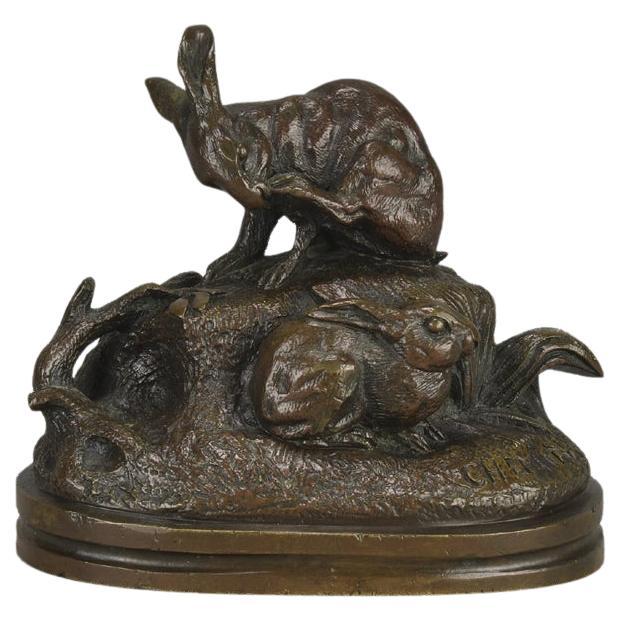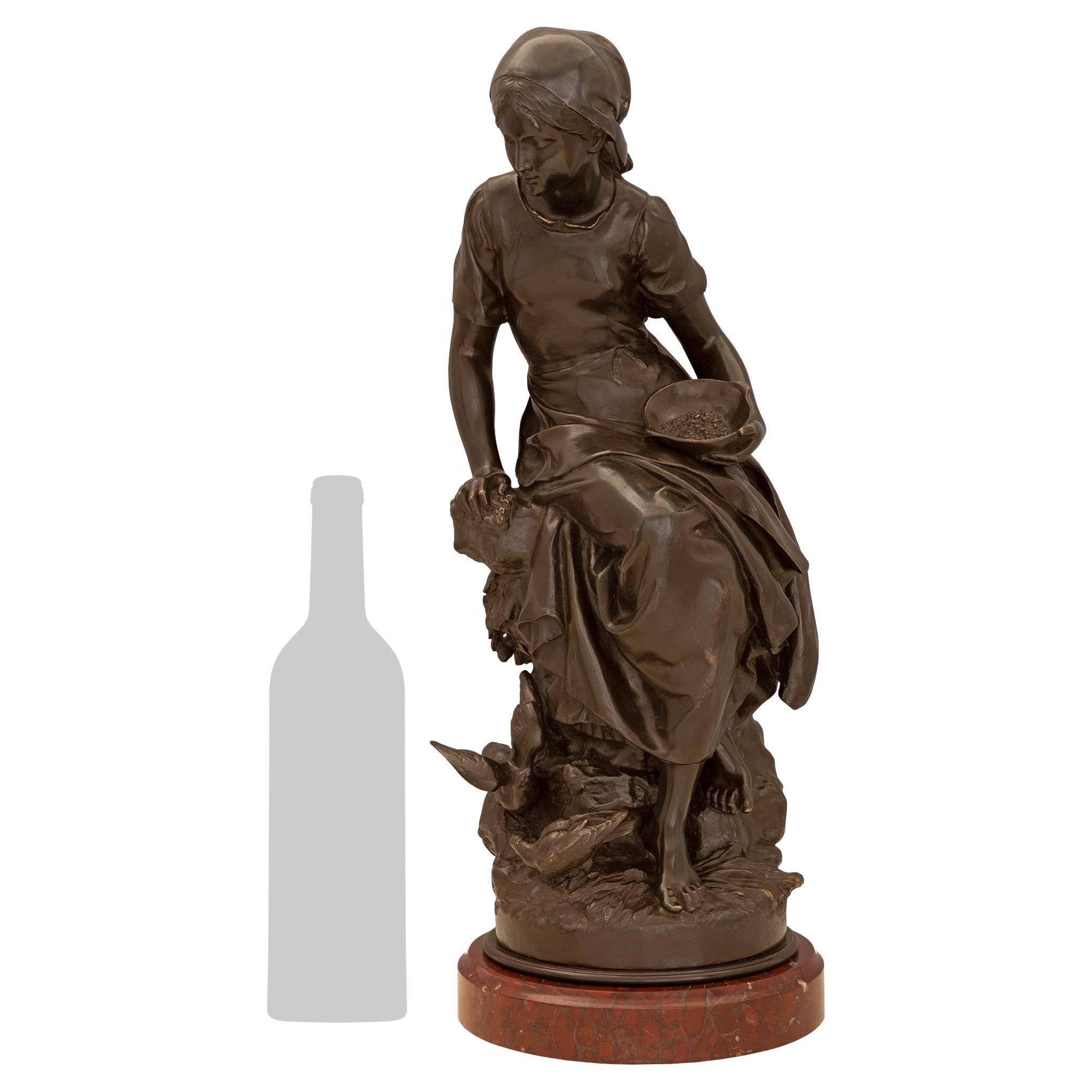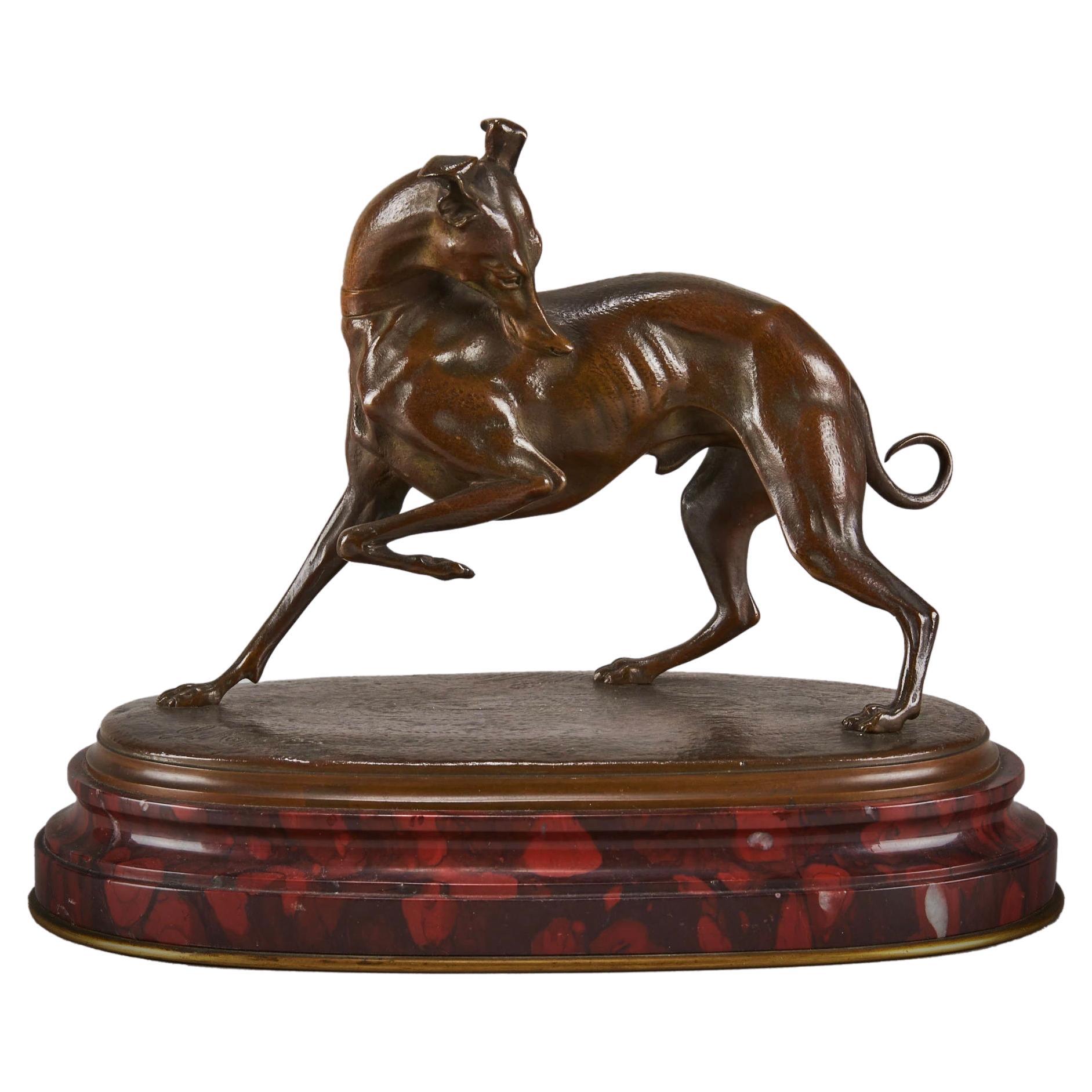Items Similar to French 19th Century Patinated Bronze Entitled ‘Chemin Des Roses’ by August Morea
Want more images or videos?
Request additional images or videos from the seller
1 of 13
French 19th Century Patinated Bronze Entitled ‘Chemin Des Roses’ by August Morea
About the Item
A charming French 19th century patinated bronze entitled 'Chemin des Roses', Path Of the Roses, by August Moreau. The bronze is raised by a mottled circular Verde Antico marble base with its bronze signature plaque. Above is the statue of a young boy and a young girl walking side by side. The girl smiling while holding her dress up with roses falling from it. The boy puts his arm on her shoulder while his straw hat hangs on his back. All original and rich patina through out.
- Creator:Auguste Moreau (Metalworker)
- Dimensions:Height: 23.5 in (59.69 cm)Width: 12 in (30.48 cm)Depth: 8.75 in (22.23 cm)
- Materials and Techniques:
- Place of Origin:
- Period:
- Date of Manufacture:19th Century
- Condition:Wear consistent with age and use.
- Seller Location:West Palm Beach, FL
- Reference Number:
About the Seller
5.0
Gold Seller
These expertly vetted sellers are highly rated and consistently exceed customer expectations.
Established in 1996
1stDibs seller since 2012
277 sales on 1stDibs
Typical response time: <1 hour
- ShippingRetrieving quote...Ships From: West Palm Beach, FL
- Return PolicyA return for this item may be initiated within 3 days of delivery.
More From This SellerView All
- French 19th Century Louis XVI St. Patinated Bronze and Marble StatueBy Auguste MoreauLocated in West Palm Beach, FLA charming French 19th century Louis XVI st. patinated bronze and marble statue, signed Auguste Moreau. The statue is raised by a fine circular marble base. The bronze above depicts ...Category
Antique 19th Century French Louis XVI Figurative Sculptures
MaterialsMarble, Bronze
- French 19th Century Patinated Bronze StatueLocated in West Palm Beach, FLA charming and very high quality French 19th century patinated bronze statue. The statue is raised by an oblong shaped base with ...Category
Antique 19th Century French Figurative Sculptures
MaterialsBronze
- French 19th Century Patinated Bronze StatueBy Mathurin MoreauLocated in West Palm Beach, FLA charming high quality French 19th century patinated bronze statue named 'Paysanne nourrissant des oiseaux', by Mathurin Moreau....Category
Antique 19th Century French Figurative Sculptures
MaterialsMarble, Bronze
- Pair of French 19th Century Patinated Bronze StatuesLocated in West Palm Beach, FLA wonderful and very detailed pair of French 19th century patinated bronze statues. Each is raised on a square base with the word...Category
Antique 19th Century French Louis XVI Figurative Sculptures
MaterialsBronze
- French 19th Century Louis XVI Style Patinated BronzeLocated in West Palm Beach, FLA wonderful French 19th century Louis XVI st. patinated bronze. The bronze is raised on a square ormolu base with concave corners. Two nude bathing maidens frolic in the waves with t...Category
Antique 19th Century French Louis XVI Figurative Sculptures
MaterialsBronze, Ormolu
- French 19th Century Neoclassical Style Patinated Bronze BustLocated in West Palm Beach, FLA handsome French 19th century Neo-Classical st. patinated bronze, ormolu and marble bust of David. The bust is raised by an elegant circular marble socle pedestal with a fine mottle...Category
Antique 19th Century French Neoclassical Busts
MaterialsMarble, Bronze, Ormolu
You May Also Like
- A 19th Century French Patinated Bronze Sculpture entitled, "Gloria Patria".Located in Los Angeles, CAA fine 19th Century French Patinated Bronze Sculpture - "Gloria Patria" (Homeland Glory) by Eugene Marioton. Titled on the front of the base: Gloria Patria Signed: Marioton Dimens...Category
Antique 19th Century French Napoleon III Sculptures
MaterialsBronze
- 19th Century Animalier Bronze entitled "Pair of Rabbits" by Victor CheminBy Joseph Victor CheminLocated in London, GBA charming early 20th Century bronze group study of two rabbits in their natural enviroment, one enjoying a scratch as it sits at the top of a mound whilst the other rabbit sits in a more hidden area at the base on the mound. The bronze with excellent rich brown patina and very fine hand chased surafce detail, raised on a stepped base and signed Chemin ADDITIONAL INFORMATION Height: 8.5 cm Width: 10 cm Depth: 6 cm Condition: Excellent Original Condition Circa: 1890 Materials: Bronze SKU: 9010 ABOUT Victor Joseph Chemin (French, 1825 ~ 1901) Chemin was an animal sculptor. He was a pupil Antoine Louis Barye, Chemin made his salon début in Paris in 1857. He produced models of dogs, foxes and...Category
Antique Late 19th Century French Art Nouveau Animal Sculptures
MaterialsBronze
- Late-19th Century French Animalier Bronze Entitled "Turning Whippet" by L MayerBy Louis MayerLocated in London, GBDelightful late19th century French Animaliers bronze study of a turning whippet looking around in an attitude to play, with rich brown colour and fine hand chased surface detail. Sig...Category
Antique 19th Century French Art Nouveau Animal Sculptures
MaterialsMarble, Griotte Marble, Bronze
- 19th Century Animalier French Bronze Entitled "Taureau Debout" by Rosa BonheurBy Rosa BonheurLocated in London, GB"Taureau Debout" by Rosa Bonheur. An excellent late 19th Century French animalier bronze study of a standing bull with fine hand chased surface that accentuates the muscle definition of the subject, signed Rosa B. ADDITIONAL INFORMATION Measures: Width: 32 cm Height: 18 cm Depth: 11cm Condition: Excellent Original Condition Circa: 1870 Materials: Bronze Book reference: Animals in Bronze by Christopher Payne Page no. 174 DESCRIPTION Bonheur, Rosa (1822-1899) The most popular artist of nineteenth-century France, Rosa Bonheur was also one of the first renowned painters of animals and the first woman awarded the Grand Cross by the French Legion of Honor. A professional artist with a successful career, Bonheur lived in two consecutive committed relationships with women. Born on March 16, 1822 in Bordeaux, Marie Rosalie Bonheur was the oldest of the four children of Raimond Oscar Bonheur (1796-1849) and Sophie Marquis. Bonheur's father was an art teacher who came from a poor family, while her mother, a musician, had descended from a middle-class family and had been her husband's art student. Bonheur's father, who taught drawing and landscape painting, was an ardent member of the utopian Saint Simeon society. The group held idealistic beliefs about the reform of work, property, marriage, and the role of women in society. Most importantly, for the artist's future, the Saint Simeons questioned traditional gender norms and firmly believed in the equality of women. While teaching artistic techniques to his oldest daughter, Raimond Bonheur also encouraged her independence and taught her to consider art as a career. In 1828 Raimond Bonheur joined the Saint Simeons at their retreat outside Paris. Sophie and the children joined him in Paris the following year. Four years later, however, Raimond abandoned his family to live in isolation with his fellow Saint Simeons. Sophie Bonheur died in 1833 at the age of thirty-six. Rosa was only eleven years old when her mother died, but she was aware of the heavy price her mother paid for married life with a man who was more dedicated to his own ideals than to meeting his family's needs. Rosa also saw that her mother's marriage led to poverty and her death from exhaustion. After her mother's death, Bonheur was taken in by the Micas family who resided nearby. Mme Micas and Bonheur's mother had been friends. When Mme Bonheur died, the Micas family paid Raimond Bonheur's debts and cared for Rosa. Their daughther, Nathalie, who would later become an amateur inventor and unschooled veterinarian, and Rosa became enamored with each other. When Rosa Bonheur began her career as a professional artist, she had already been trained by her father who had allowed her to study in all male classes. Rosa also learned by sketching masterworks at the Louvre from the age of fourteen, and later, by studying with Léon Cogniet. From the very beginning, Bonheur's favorite subject was animals. She learned their anatomy completely by dissecting them in local slaughterhouses. She also visited the horse market two times a week. Study of animals by direct observation led to the formation of the realist style in which Bonheur worked. It was for such work that Bonheur obtained written permission from the French government to wear men's slacks. Her working attire also consisted of a loose smock and heavy boots that protected her feet from the dangerous environment in which she painted. The style of dress that the artist adopted for work and home may well have been influenced by her father's attire, which was based on St. Simeonian clothing experiments. Bonheur also cropped her hair, perhaps to facilitate her work. She did, however, always wear dresses for social occasions because she knew that appropriate dress would further her career. Bonheur earned a successful living as a painter of animals. She exhibited at the annual Paris Salon regularly from the age of nineteen in 1841 through 1853, when she was thirty-one. She won the salon's gold medal at the age of twenty-six in 1848 and was commissioned by the French government to paint Plowing on the Nivernais in 1849. In the same year Bonheur and her sister Juliette became directors of l'École gratuite de dessin pour les jeunes filles, a post their father had once held. Bonheur completed her most renowned work, The Horse Fair, in 1855. The successful representation of percherons (a breed native to Normandy) was purchased by Ernest Gambart, a London art dealer whose gallery specialized in work by French artists. He exhibited The Horse Fair in London where Bonheur visited with Nathalie. Queen Victoria requested a private viewing of the painting at Windsor Castle. It would later be purchased in 1887 by Cornelius Vanderbilt and donated to the new Metropolitan Museum of Art in New York City. Bonheur's trip to England allowed her to meet Charles Eastlake, then President of the Royal Academy, John Ruskin, the English writer and critic, and Edwin Landseer, the British animalier. She also toured the English and Scottish countrysides and executed some paintings based on her observations of new breeds of animals found there. Gambart made engravings of Bonheur's work, including The Horse Fair, and sold them in England, Europe, and the United States. Bonheur became one of the most renowned painters of the time. Little girls, such as Anna Klumpke in the United States, even had dolls in her likeness, much as American girls played with Shirley Temple dolls...Category
Antique 19th Century French Art Nouveau Animal Sculptures
MaterialsBronze
- 19th Century French Silver Patinated Bronze BorzoiLocated in Miami, FLA 19th century French silver patinated bronze borzoi on a cream marble base. A beautiful depiction of this sleek handsome dog. In very good condition wit...Category
Antique Late 19th Century French Neoclassical Animal Sculptures
MaterialsMarble, Bronze
- 19th Century French Patinated Spelter Sculpture of Young Woman Signed A. MoreauBy Auguste MoreauLocated in Dallas, TXThis elegant figure composition was crafted in France circa 1880. Built of spelter, the statue stands on a shaped black and grey marble base, and depicts a young female beauty seated...Category
Antique Late 19th Century French Figurative Sculptures
MaterialsMarble, Bronze
Recently Viewed
View AllMore Ways To Browse
The Antique Rose
French Furniture Roses
Path Roses
Path With Roses
Marble And Bronze Roses
Antique Rose Dresses
Bronze Moreau Sculpture
Moreau Bronze Sculpture
Smiling Girl
Antico Verde
Moreau French Decorative Bronze
A Moreau Bronze Sculpture
Verde Antico Marble
Bronze Girls Bronze Marble
Rose Gold Marble
Moreau Marble
Girl And Boy Sculpture
Statue Of A Boy





